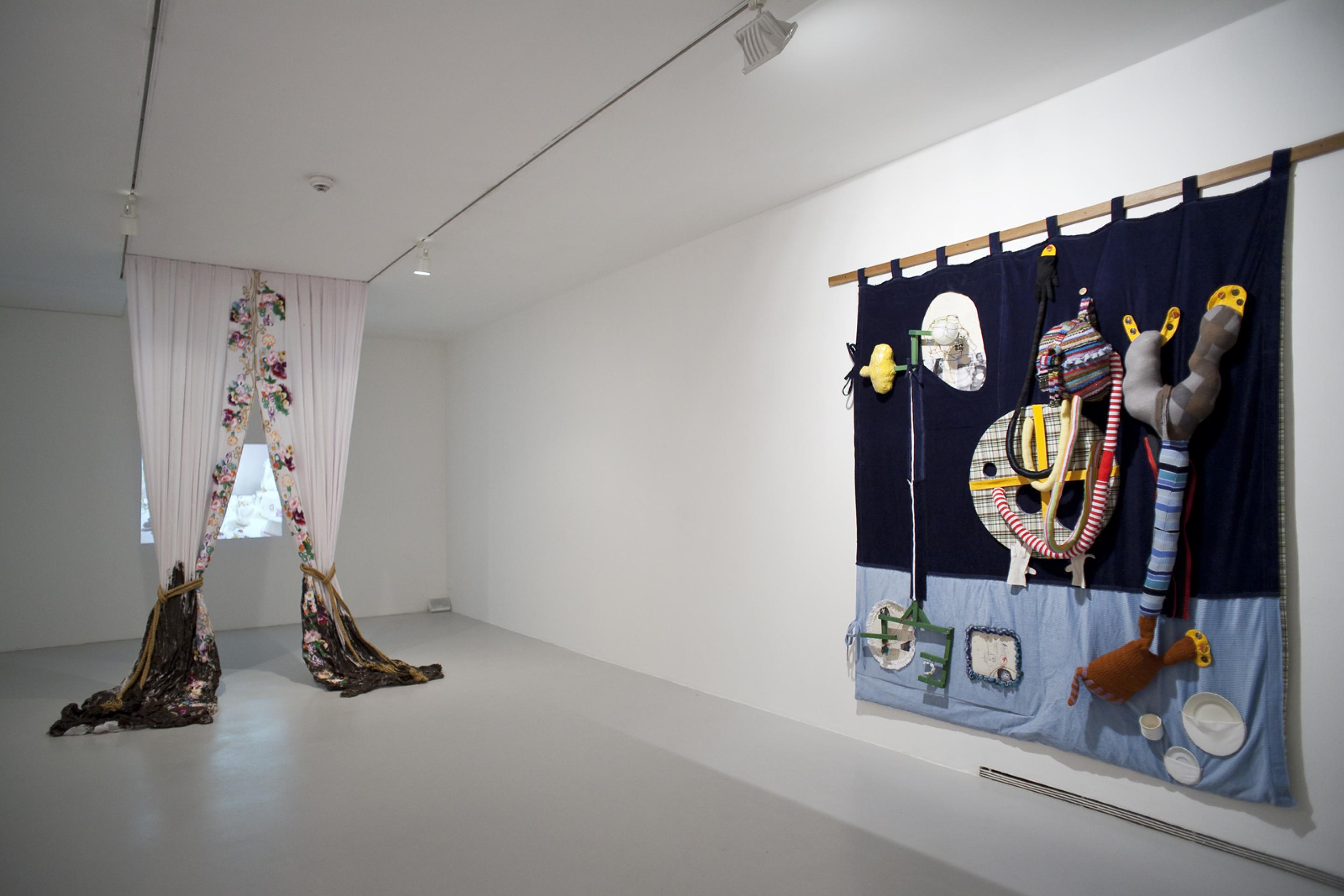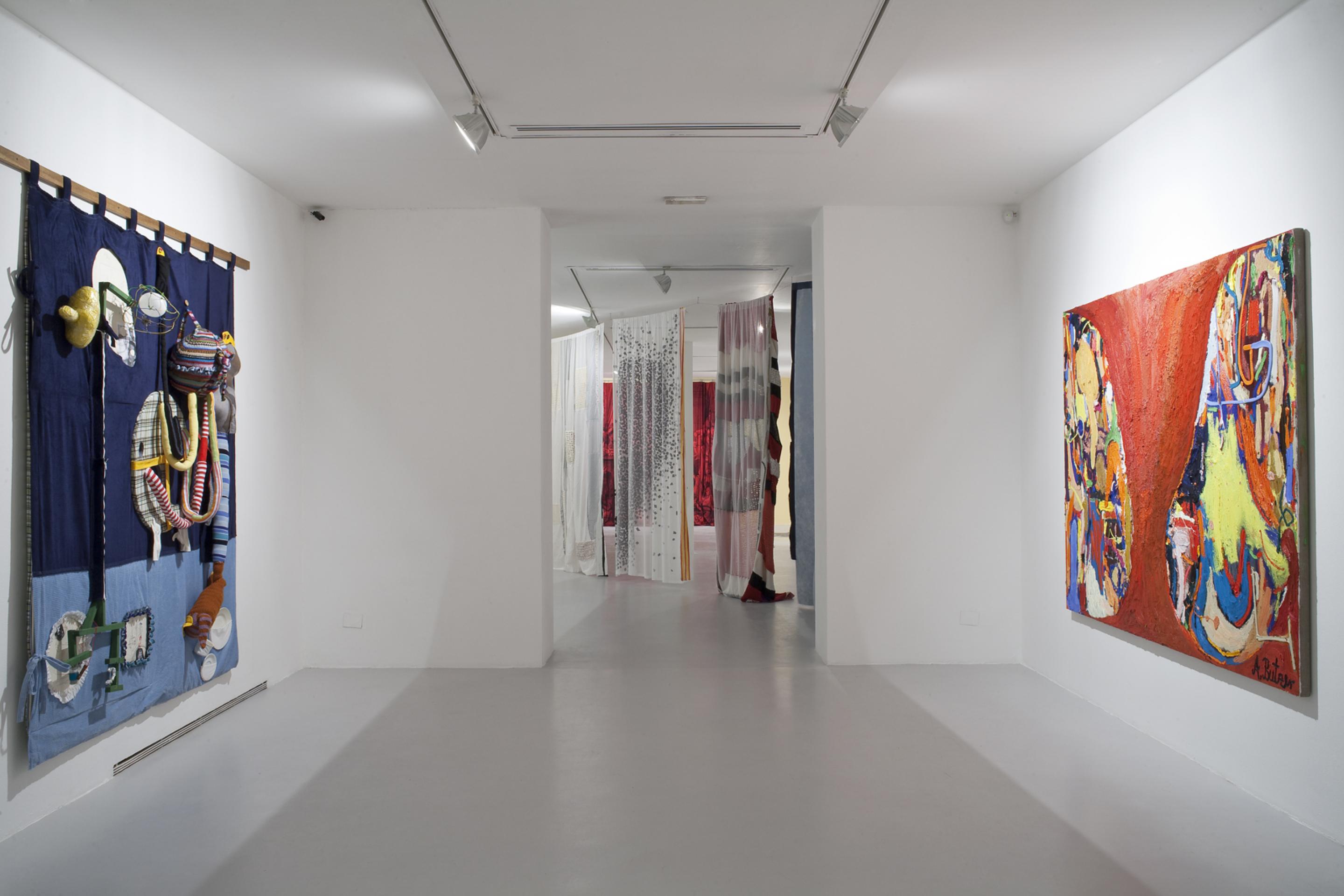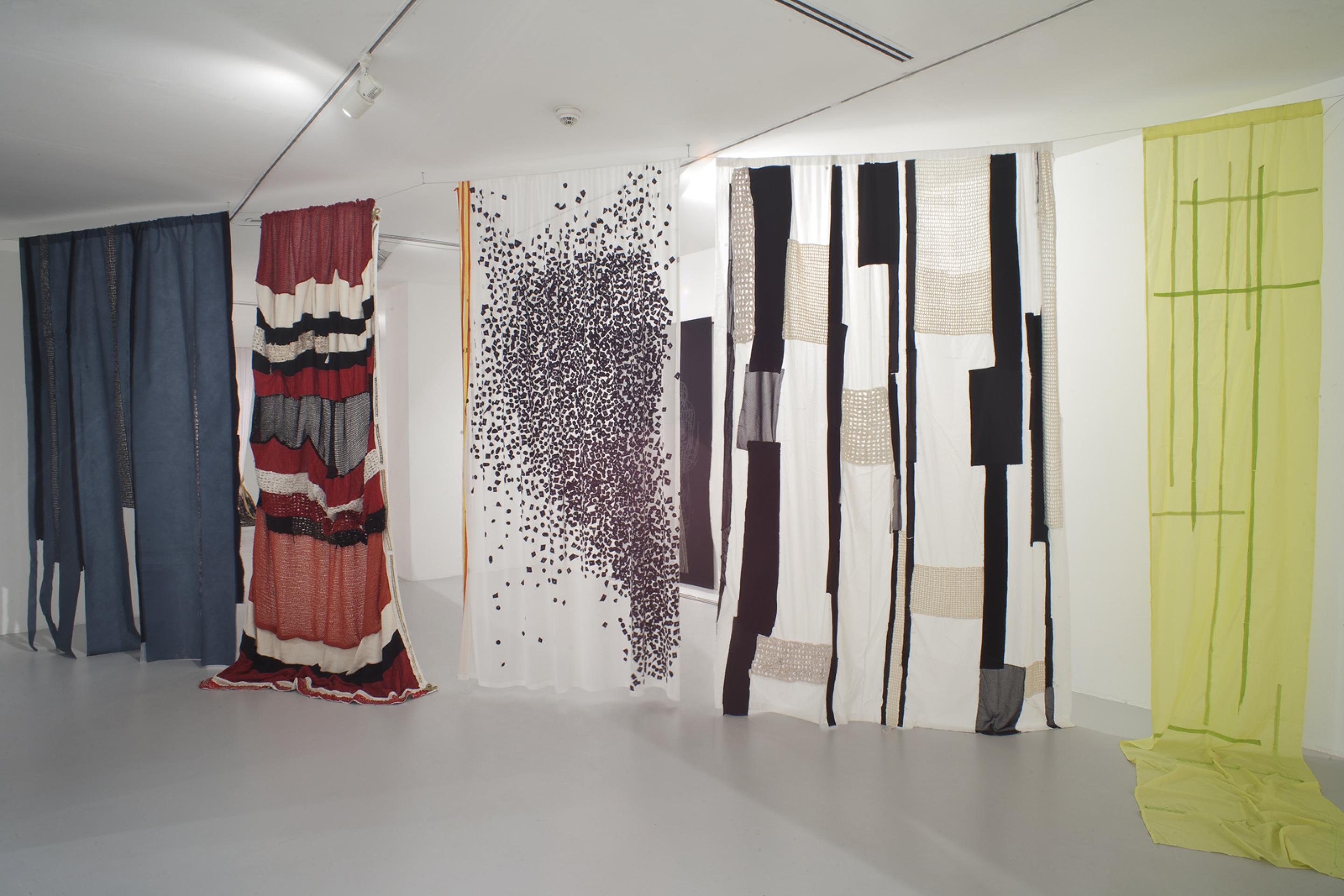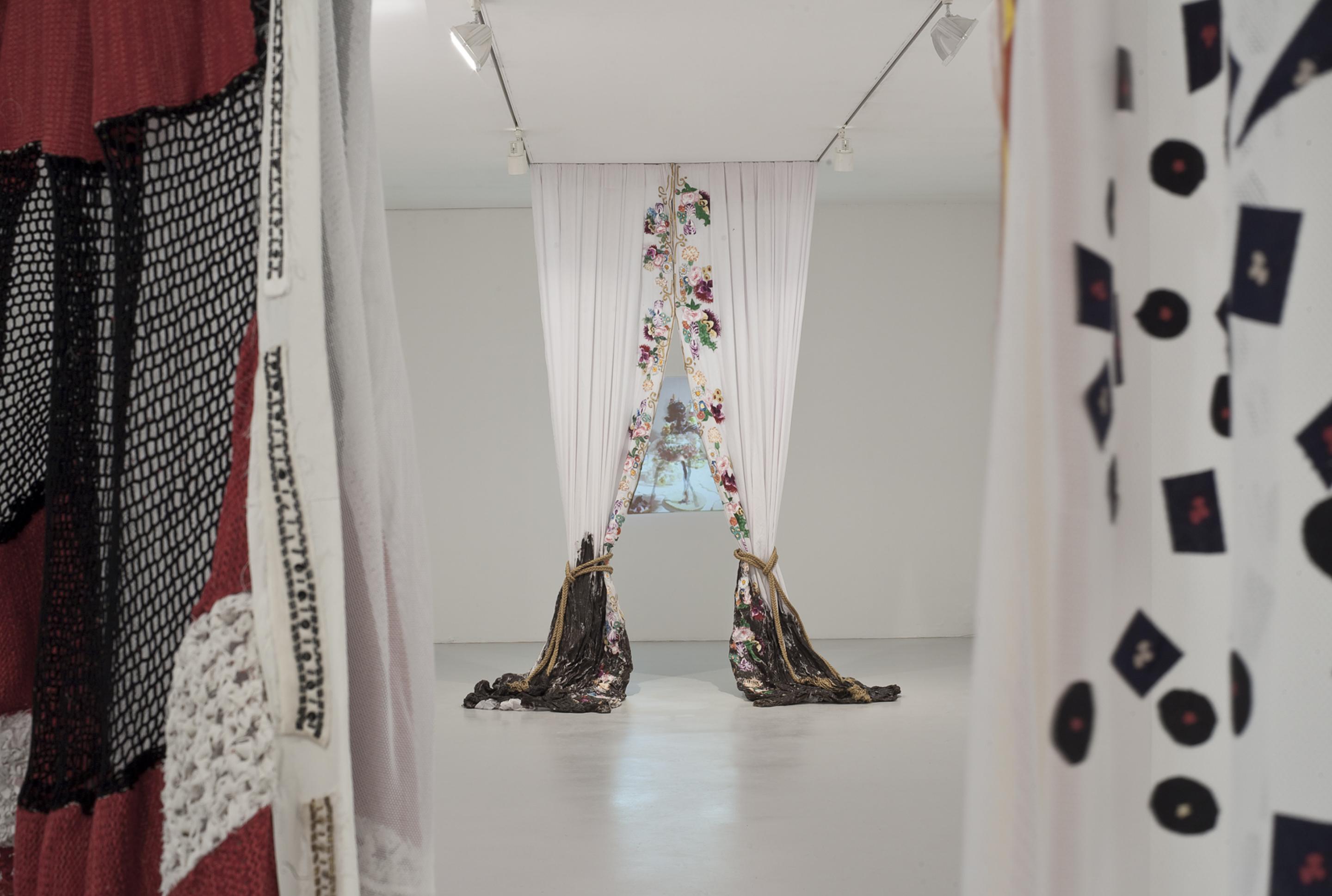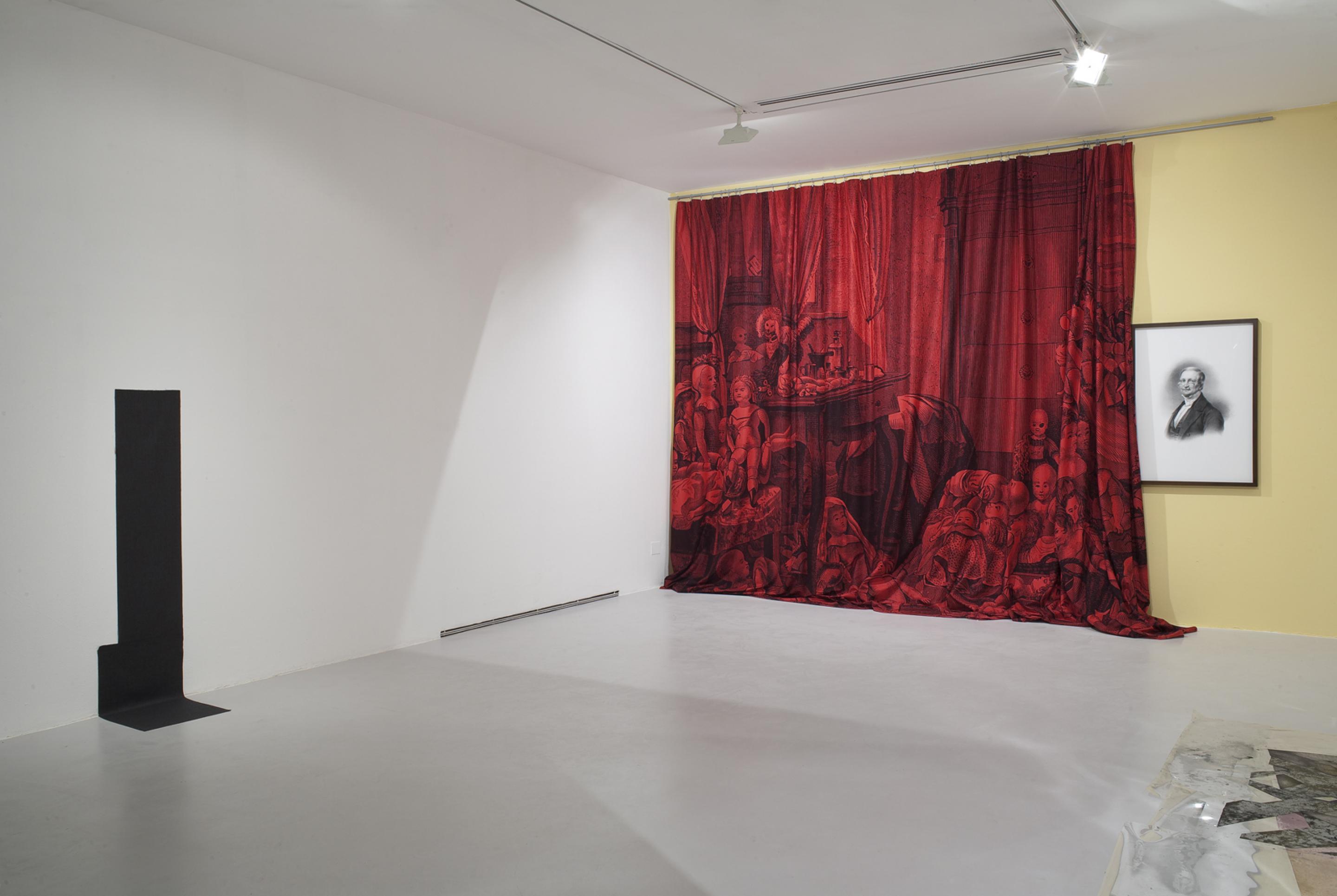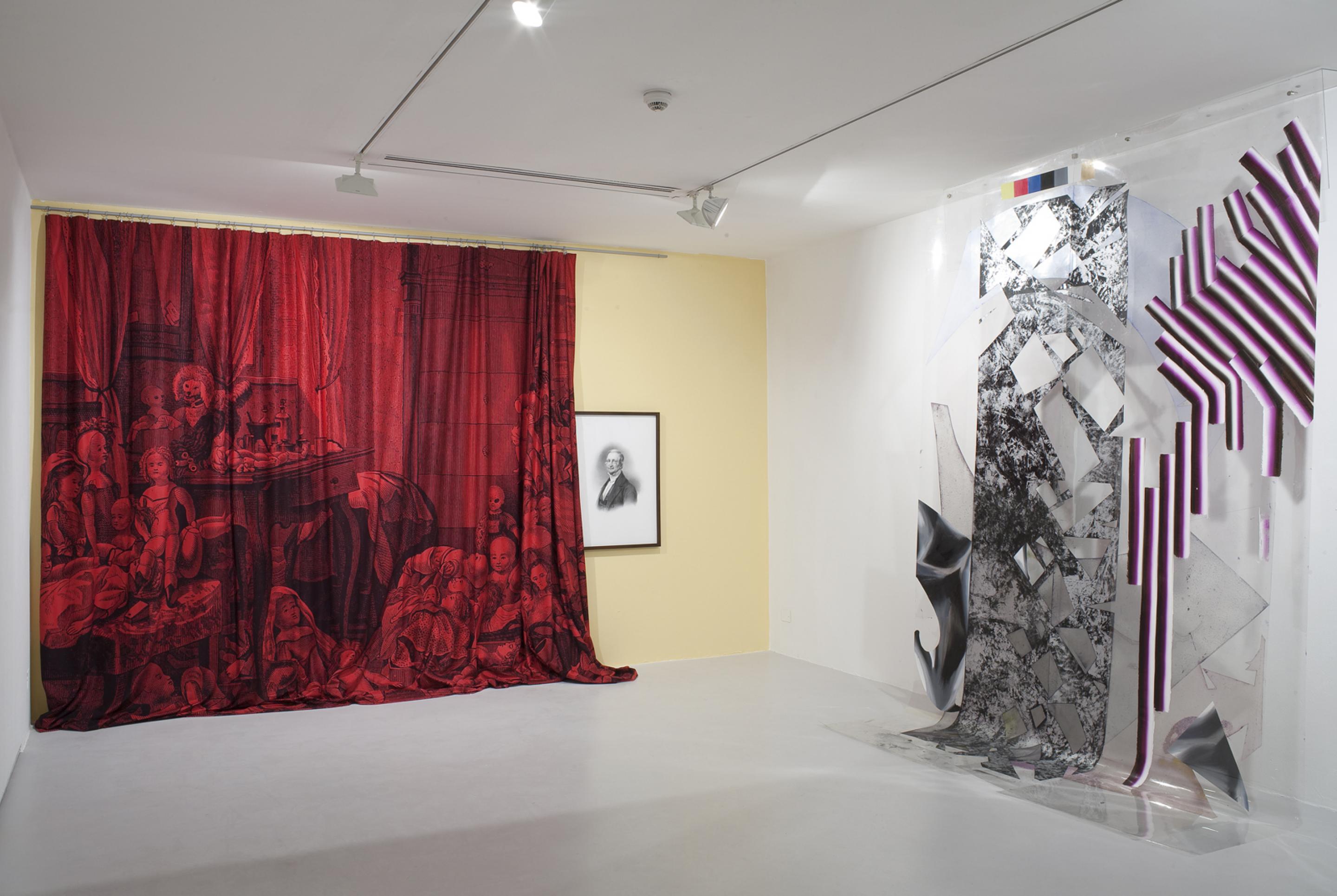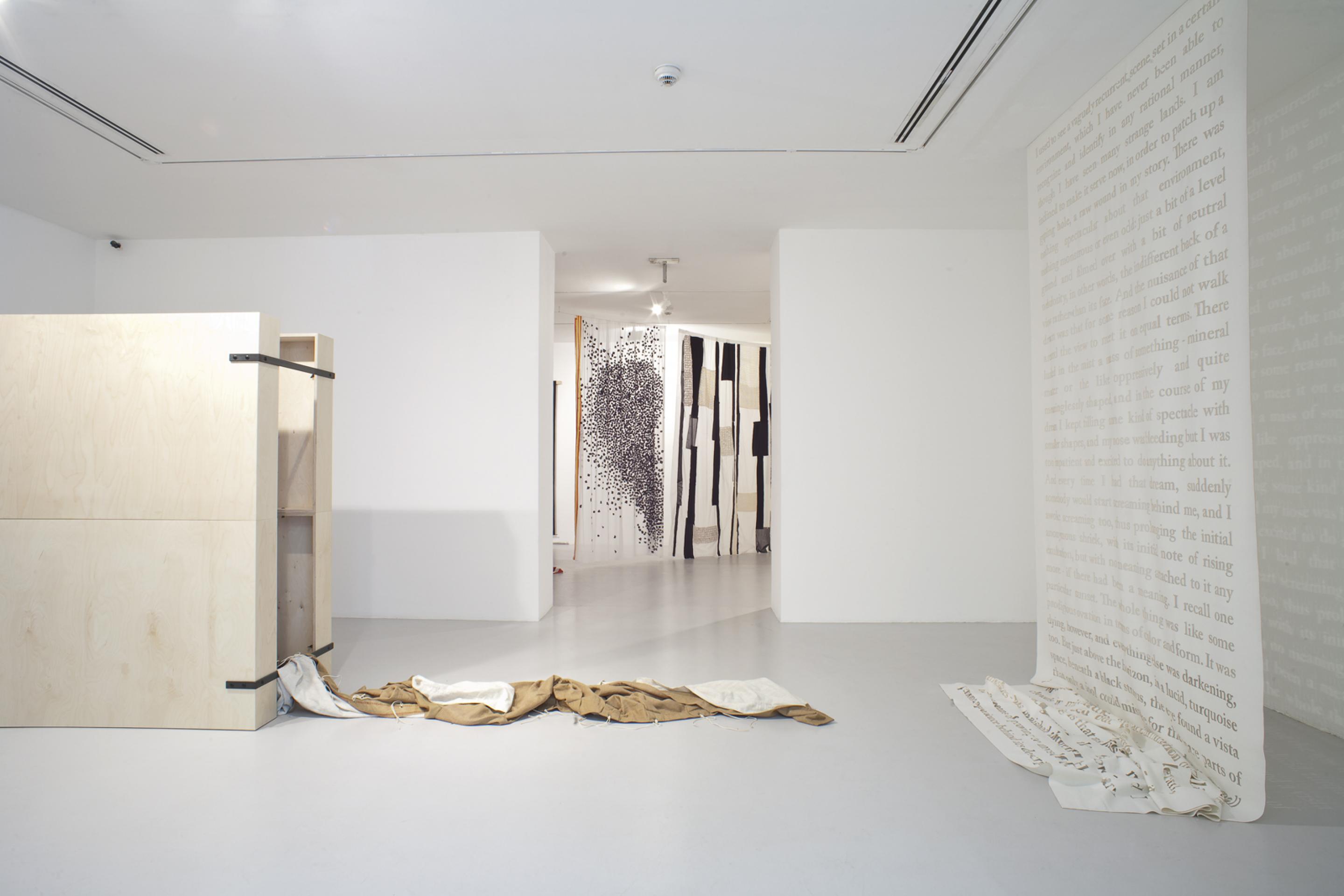GroupSHOW
Behind the Curtain
Gió Marconi, Milan
22.04.–29.05.2010
Behind the Curtain
Gió Marconi, Milan
22.04.–29.05.2010
IT
Group Show
Behind the Curtain
Inaugurazione: giovedì 22 Aprile 2010 dalle 19 alle 21
23 aprile - 29 maggio 2010
martedì - sabato; 11-19
La Galleria Giò Marconi è lieta di annunciare la mostra collettiva "Behind the Curtain" che presenta tende di diversi artisti e di ogni genere.
Il lavoro di Rosa Barba "The indifferent back of a view rather than its face" è proprio un lungo testo (un estratto dall'autobiografia di Vladimir Nabokov) dove le lettere sono ricavate per sottrazione dal tessuto e le tende diventano due grandi pagine spiegate, che raccontano per frammenti la luce, l'ombra, il riflesso. Il lavoro prende vita, infatti, quando un fascio di luce illumina dall'alto la tenda, e l'ombra delle lettere viene proiettata sulla parete dietro.
John Bock ci presenta una tenda che sembra un mantello rituale, o una tovaglia coloratissima, puntellata di figure zoomorfe e oggetti: piatti, tazze e gli oggetti oblunghi tipici dell'artista, fatti di lana o altri tessuti. La tenda, bidimensionale per definizione, diventa qui una vera e propria installazione tridimensionale.
Kerstin Braetsch ci porpone PrinZIP, lavoro in tre parti colorato con spray su foglio trasparente. Appeso al soffitto questo grande foglio è estremamente fragile e funziona come un divisorio trasparente e fluttuante.
Matthew Brannon trasforma la tela in una tenda minimale: appesa ad un listello d'ottone e resa rigida da un altro listello che si trova sul lato inferiore, è al tempo stesso quadro e passaggio, impreziosito da un elaborato ricamo a mano.
Il lavoro di Tom Burr, estremamente concettuale, emerge da un parallelepipedo di legno aperto, dal quale esce come liberata.
Andrè Butzer, con una grande tela 180 x 240, un dipinto astratto che si intrufola tra i tendaggi, ripropone l'idea dell'opera d'arte come confine, punto di contatto tra due mondi, distinti eppure strettamente legati l'uno all'altro Nathalie Djurberg sporca una classicissima tenda rosa che dipinge con motivi floreali e spesse pennellate di colore. Appesantita, la tenda rimane incollata a terra e nasconde dietro di sè una proiezione di uno dei film dell'artista.
Il lavoro minimal di Kitty Krauss si basa sull'idea di quadrato, con cui l'artista gioca spesso: in questo caso l'elemento è ricavato da un vestito elegante da uomo , che l'artista ha tagliato in due parti rettangolari, lasciando la cucitura al centro e lasciando scivolare una parte sul pavimento.
Tobias Rehberger, invece, dedica le sue tende a cinque personaggi dello spettacolo italiani: Benedetta Barzini, Caterina Caselli, Massimo Ranieri, Rita Pavone, Sabina Ciuffini. Personaggi che l’artista ritiene abbiano inciso in modo particolare in un determinato momento della loro carriera sull’immaginario collettivo. Loro indumenti sono stati rielaborati per essere trasformati in veri e propri tendaggi.
Untitled (Dolls) di Markus Schinwald, il più opulento dei lavori in mostra, capovolge la funzione della tenda, che da strumento per cancellare agli occhi la visione di uno spettacolo, diventa spettacolo essa stessa: vediamo una stanza popolata di bambole che paiono animarsi, anche per il movimento che le pieghe della tenda induce loro. Dietro le bambole e la loro vita silenziosa, altri ritratti si nascondono, che solo chi osa spostare la tenda potrà vedere.
Gedy Siboni sposta l'orizzontale in verticale e così un tappeto si trova improvvisamente a coprire una parete e un rattoppo diventa un motivo ornamentale. In un intrico di barriere e ostacoli, che sono allo stesso tempo quadri o sculture di grandi dimensioni, possiamo assaporare il sottile piacere di spostare la tenda, spiare o semplicemente immaginare cosa ci potrebbe essere oltre: ogni artista ci regala la possibilità di farlo in modo diverso.
Behind the Curtain
Inaugurazione: giovedì 22 Aprile 2010 dalle 19 alle 21
23 aprile - 29 maggio 2010
martedì - sabato; 11-19
La Galleria Giò Marconi è lieta di annunciare la mostra collettiva "Behind the Curtain" che presenta tende di diversi artisti e di ogni genere.
Il lavoro di Rosa Barba "The indifferent back of a view rather than its face" è proprio un lungo testo (un estratto dall'autobiografia di Vladimir Nabokov) dove le lettere sono ricavate per sottrazione dal tessuto e le tende diventano due grandi pagine spiegate, che raccontano per frammenti la luce, l'ombra, il riflesso. Il lavoro prende vita, infatti, quando un fascio di luce illumina dall'alto la tenda, e l'ombra delle lettere viene proiettata sulla parete dietro.
John Bock ci presenta una tenda che sembra un mantello rituale, o una tovaglia coloratissima, puntellata di figure zoomorfe e oggetti: piatti, tazze e gli oggetti oblunghi tipici dell'artista, fatti di lana o altri tessuti. La tenda, bidimensionale per definizione, diventa qui una vera e propria installazione tridimensionale.
Kerstin Braetsch ci porpone PrinZIP, lavoro in tre parti colorato con spray su foglio trasparente. Appeso al soffitto questo grande foglio è estremamente fragile e funziona come un divisorio trasparente e fluttuante.
Matthew Brannon trasforma la tela in una tenda minimale: appesa ad un listello d'ottone e resa rigida da un altro listello che si trova sul lato inferiore, è al tempo stesso quadro e passaggio, impreziosito da un elaborato ricamo a mano.
Il lavoro di Tom Burr, estremamente concettuale, emerge da un parallelepipedo di legno aperto, dal quale esce come liberata.
Andrè Butzer, con una grande tela 180 x 240, un dipinto astratto che si intrufola tra i tendaggi, ripropone l'idea dell'opera d'arte come confine, punto di contatto tra due mondi, distinti eppure strettamente legati l'uno all'altro Nathalie Djurberg sporca una classicissima tenda rosa che dipinge con motivi floreali e spesse pennellate di colore. Appesantita, la tenda rimane incollata a terra e nasconde dietro di sè una proiezione di uno dei film dell'artista.
Il lavoro minimal di Kitty Krauss si basa sull'idea di quadrato, con cui l'artista gioca spesso: in questo caso l'elemento è ricavato da un vestito elegante da uomo , che l'artista ha tagliato in due parti rettangolari, lasciando la cucitura al centro e lasciando scivolare una parte sul pavimento.
Tobias Rehberger, invece, dedica le sue tende a cinque personaggi dello spettacolo italiani: Benedetta Barzini, Caterina Caselli, Massimo Ranieri, Rita Pavone, Sabina Ciuffini. Personaggi che l’artista ritiene abbiano inciso in modo particolare in un determinato momento della loro carriera sull’immaginario collettivo. Loro indumenti sono stati rielaborati per essere trasformati in veri e propri tendaggi.
Untitled (Dolls) di Markus Schinwald, il più opulento dei lavori in mostra, capovolge la funzione della tenda, che da strumento per cancellare agli occhi la visione di uno spettacolo, diventa spettacolo essa stessa: vediamo una stanza popolata di bambole che paiono animarsi, anche per il movimento che le pieghe della tenda induce loro. Dietro le bambole e la loro vita silenziosa, altri ritratti si nascondono, che solo chi osa spostare la tenda potrà vedere.
Gedy Siboni sposta l'orizzontale in verticale e così un tappeto si trova improvvisamente a coprire una parete e un rattoppo diventa un motivo ornamentale. In un intrico di barriere e ostacoli, che sono allo stesso tempo quadri o sculture di grandi dimensioni, possiamo assaporare il sottile piacere di spostare la tenda, spiare o semplicemente immaginare cosa ci potrebbe essere oltre: ogni artista ci regala la possibilità di farlo in modo diverso.
EN
Group Show
Behind the Curtain
Opening: Thursday April 22, 2010; 7pm-9pm
April 23 - May 29, 2010
From Tuesday to Saturday; 11am-7pm
Gió Marconi Gallery is very pleased to announce the group show Behind the Curtain. Curtains of various artists are on display:
Rosa Barba's work "The indifferent Back of a View rather than its Face" has been laser-cut to reveal a text (an excerpt of Vladimir Nabokov’s autobiography) that speaks of light, shadows, and reflections. Indeed, this text is literally produced when a beam of light is projected from the ceiling at the curtain, casting a shadow of the story onto the back wall.
John Bock’s curtain resembles an actual tablecloth onto which he positions various plates and cups and his traditional sausage shaped objects made of different fabrics and wool. In attaching all these colourful objects the per se two-dimensional curtain becomes a three-dimensional installation.
Kerstin Braetsch proposes PrinZIP, a three part multi coloured work made of spraypainted transparencies. Attached to the ceiling the seemingly fragile transparency is free floating and thereby almost functions as a transparent room divider.
Matthew Brannon’s “Messy Affair” shows a plain black cloth which is embellished with an elaborate abstract embroidery. Tom Burr's very conceptual curtain emerges from an open wooden structure and looks like the light brown cloth has just been dropped to the floor and left behind.
Andrè Butzer shows with his 180 x 240 cm big red abstract painting “Wie die Welt leuchtet” (“How the World is Illuminated”), reminds that the boundaries within art are blurred Nathalie Djurberg’s folkloristic thickly painted flower curtain actually acts as an entreé into her world and functions as a real curtain in that it “hides” a projection with one of the artist’s films.
Kitty Krauss' minimal works often play with the idea of a black square. In the piece for the show the black element came from a man’s business suit that the artist has cut into two rectangular shapes, leaving the seam in the middle, and then suspending the pieces from the wall, letting the material slide limply across the floor.
Tobias Rehberger dedicates his curtains to five personages of the Italian show business: Benedetta Barzini, Caterina Caselli, Massimo Ranieri, Rita Pavone and Sabina Ciuffini. They are people who, in their particular time and moment, have left their traces on the collective consciousness.
Markus Schinwald’s “Untitled (Dolls)” is, with its rich dark red folds and heavy drapery, the most opulent of the curtains on display. In Schinwald’s works curtains are a reoccuring theme. The curtain is imprinted with various dolls in different kinds of shapes and sizes: they are sitting, lying, and are piled on top of eachother. The paintings hiding behind can only be seen by those who dare to take a glimpse behind the curtain.
Gedi Sibony puts up a badly cut out piece of carpet onto the wall. A patch made of light brown adhesive tape thereby becomes an ornamental decoration and bridges the gap between article of daily use and artwork.
Behind the Curtain
Opening: Thursday April 22, 2010; 7pm-9pm
April 23 - May 29, 2010
From Tuesday to Saturday; 11am-7pm
Gió Marconi Gallery is very pleased to announce the group show Behind the Curtain. Curtains of various artists are on display:
Rosa Barba's work "The indifferent Back of a View rather than its Face" has been laser-cut to reveal a text (an excerpt of Vladimir Nabokov’s autobiography) that speaks of light, shadows, and reflections. Indeed, this text is literally produced when a beam of light is projected from the ceiling at the curtain, casting a shadow of the story onto the back wall.
John Bock’s curtain resembles an actual tablecloth onto which he positions various plates and cups and his traditional sausage shaped objects made of different fabrics and wool. In attaching all these colourful objects the per se two-dimensional curtain becomes a three-dimensional installation.
Kerstin Braetsch proposes PrinZIP, a three part multi coloured work made of spraypainted transparencies. Attached to the ceiling the seemingly fragile transparency is free floating and thereby almost functions as a transparent room divider.
Matthew Brannon’s “Messy Affair” shows a plain black cloth which is embellished with an elaborate abstract embroidery. Tom Burr's very conceptual curtain emerges from an open wooden structure and looks like the light brown cloth has just been dropped to the floor and left behind.
Andrè Butzer shows with his 180 x 240 cm big red abstract painting “Wie die Welt leuchtet” (“How the World is Illuminated”), reminds that the boundaries within art are blurred Nathalie Djurberg’s folkloristic thickly painted flower curtain actually acts as an entreé into her world and functions as a real curtain in that it “hides” a projection with one of the artist’s films.
Kitty Krauss' minimal works often play with the idea of a black square. In the piece for the show the black element came from a man’s business suit that the artist has cut into two rectangular shapes, leaving the seam in the middle, and then suspending the pieces from the wall, letting the material slide limply across the floor.
Tobias Rehberger dedicates his curtains to five personages of the Italian show business: Benedetta Barzini, Caterina Caselli, Massimo Ranieri, Rita Pavone and Sabina Ciuffini. They are people who, in their particular time and moment, have left their traces on the collective consciousness.
Markus Schinwald’s “Untitled (Dolls)” is, with its rich dark red folds and heavy drapery, the most opulent of the curtains on display. In Schinwald’s works curtains are a reoccuring theme. The curtain is imprinted with various dolls in different kinds of shapes and sizes: they are sitting, lying, and are piled on top of eachother. The paintings hiding behind can only be seen by those who dare to take a glimpse behind the curtain.
Gedi Sibony puts up a badly cut out piece of carpet onto the wall. A patch made of light brown adhesive tape thereby becomes an ornamental decoration and bridges the gap between article of daily use and artwork.
